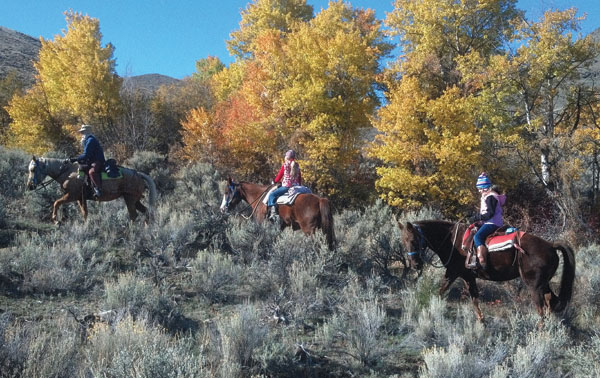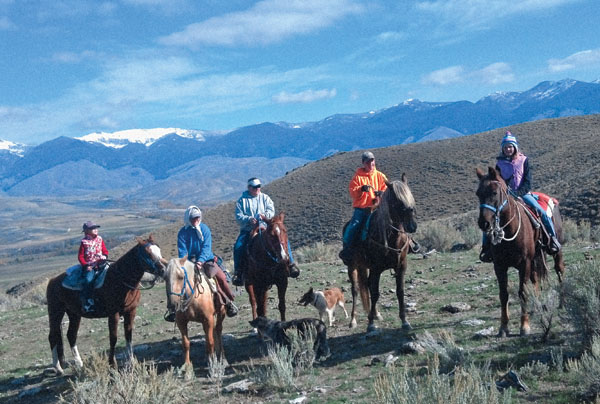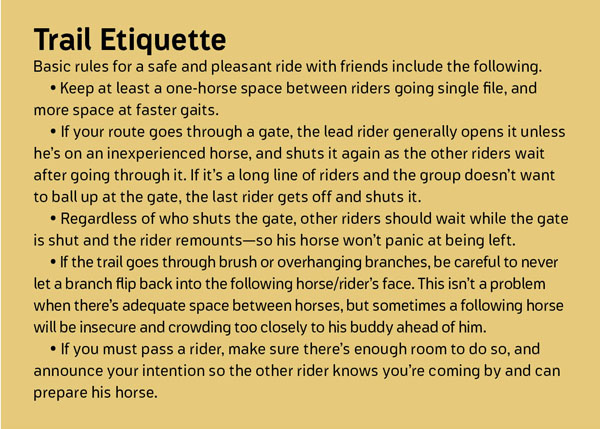Your young horse in training is ready for the next step—some rides out in the big wide world with your friends. Or your trail-riding prospect is now old enough to prepare for his first competitive ride. Or the new horse you bought is one you’d like to ride out in the hills as well as in the arena. Or you’ve signed up for a renowned group trail ride and need to get your horse prepared.
[MORE: Guest Ranches for Equestrians]

If your horse hasn’t been ridden before in the company of several other horses out on the trail, it’s wise to do some preparation and training ahead of time. Some inexperienced horses are nervous or cranky in a group and need to learn proper trail manners. Others may be fine with the extra horses and glad for the company, but will wig out at perceived obstacles encountered on the trail.
The following steps will help you prepare your horse for a safe and pleasant ride.
Social Challenges
Your horse may get along fine with a stable buddy or pasturemate at home when you ride together. But riding in a group with unfamiliar horses in unfamiliar territory may blow his mind, or bring out unexpected animosities. To him, a new group is a new herd, and he may feel the need to defend his turf. Every horse is different, and you need to find your horse’s weak areas and work on them before your big outing with friends or his first major trail ride.
Aggression: This behavioral problem may be unexpected; the aggressive aspect of your horse’s personality may not become evident until you’re actually on a group ride.
If your horse is an alpha type, he might try to bully other horses that get close to him. Or he may be a mellow pussycat at home with his buddies, but suddenly become aggressive in strange company. If you and a friend are riding stablemates and take them for an outing with a larger group, your horse may be jealously protective of his buddy and become aggressive—pinning his ears and trying to bite or kick another too-close horse.
Some mares are predictably unpredictable, or become overly emotional and reactive in group settings when in heat. If your mare is socially nasty at certain stages of her cycle, make sure she doesn’t get close to another horse. Some emotional geldings also show aggression; with some it’s an instant personal dislike of the strange horse. Some insecure individuals show aggression as a defensive self-preservation tactic.
What to do: Your best preparation is to have a well-established trust-respect bond with your horse (gleaned from many hours and miles together), so that he’ll respond to your control. Then you can halt the aggressive behavior before it results in an actual bite or a kick.
If you realize your horse has a jealous or aggressive streak, practice a few rides with strange horses to get the upper hand on this problem. If your horse is acting defensively because he’s nervous and insecure, do a lot more riding with other people but keep some distance between their horses and yours until your horse becomes more at ease with riding in a group and realizes the other horses aren’t a threat.
When riding in company, always stay alert and in tune with how your horse is feeling; don’t get sloppy and inattentive, or your unpreparedness may get you, your horse, or someone else kicked or bitten. It’s your responsibility to keep your horse under control, so don’t ride with such a loose rein that he could reach over and bite another horse. Control his hindquarters with your legs and body language; you need complete control over the whole horse. Don’t let him get into a position where he could kick and make contact, but also warn the riders behind you to not crowd your horse or pass without your OK. If you know your horse is a kicker, tie a red ribbon in his tail as a warning to other riders to not “tailgate” or get too close.
Insecure or impatient when behind other horses: This is a common problem. Many energetic horses tend to be hyper, and prefer to be in front of the pack. They become upset and frustrated if they have to follow another horse, or act up out of fear they might get left behind. If your horse can’t walk quite as fast as the horse in front of him, or doesn’t want to try to walk faster (preferring to jog), he may get stressed and want to prance, or charge forward to catch up. If you try to make him remain at a calm walk, he may root at the bit or lug into it. This continual fight with your horse makes an unpleasant ride for you both.

Some horses are competitive by nature, especially if they’re bred to run or race, and want to be in front, even if everyone is just walking. Some individuals are insecure and nervous, more worried about the other horses, and not paying attention to you. If they get very far behind the horse in front of them, they truly panic.
In any given group of horses, there will be some that naturally walk faster (or slower) than others. In open country or along a dirt road, pairs or threes can ride side by side on the group ride. This alleviates some of the problem because an insecure horse always has a horse alongside him.
In rougher country, however, you may be riding single-file along a trail to avoid rocks, brush, or trees. This is more challenging for horses that are mismatched in speed of gait. If the leader is a plodder, faster-walking horses behind may be frustrated and riders have to be alert to keep from getting too close to the horse ahead. If the leader walks fast, some horses along the line will have to trot periodically to catch up, creating a continual walk-jog erratic line.
Trail etiquette comes into play here. It’s not polite to plod, trailing far behind, and then trot swiftly to catch up, especially if the horse behind you is a nervous type that doesn’t want to be left behind. When your horse takes off trotting to close the gap between you and the horse in front, the rider following you may suddenly have a horse that is stressed/panicky because he got left, and has to either try to calm the horse or give up and trot to catch up, too. If your horse absolutely can’t walk fast enough to keep up with the horse in front, resign yourself to frequent slow jogging; don’t drop very far behind or you’ll frustrate the rider behind you every time you take off to catch up.
Gully speed-ups are a perfect example of discourteous riding. Some horses like to rush through a dip in the trail, leaving the next horse behind. The horse that’s suddenly left may decide to lunge through the gully or give a disconcerting buck while rushing through it.
[MORE: Rules of the Road on the Trail]
What to do: If your horse is a hyper individual that always wants to be in front, you can’t totally change his nature but you can spend time working with him to encourage him to pay attention to your cues and body language. Work at keeping him at the gait and speed you desire, with more relaxation and less stress. You may have to start these calm sessions solo, and then ride with a friend or two after you gain rapport with your horse and control of his gaits and his attitude. Make a practice of having him follow other horses just as often as he is in the lead, trading off. Develop his patience level and manners so he can realize that his position in the line doesn’t matter, and that he can trust and respect your cues and stay calm.
For a hard-core prancer, it might help to use a mechanical hotwalker if you have access to one—where a number of horses can be exercised together in a circle. A short daily session with several other horses, in which there’s always another horse ahead of him, may help him discover that he doesn’t always have to be in front.
For the gully-rusher, practice with a buddy. Take turns leading and following. Concentrate on having your horse walk down into the gully, pausing at the bottom if necessary, and calmly walking up the other side instead of rushing and lunging.
Obstacle Challenges
Even if your horse gets along well with other horses and is well mannered, he won’t do well in a group ride across country without experience with some of the challenges he’ll meet along the trail. You don’t want him balking at a stream, refusing to cross a bridge, balking in front of a log he needs to step over, or holding up the ride by refusing to go past a scary-looking rock or stump.

Trail-proofing: Some of this important preparatory training can be done in an arena, using obstacles similar to ones you’d find in a trail-class competition (bridges, walk-overs, and so forth). These practice sessions are good for any young or inexperienced horse, to familiarize him with many things that otherwise might be spooky. However, many of the obstacles a horse might encounter out in the real world won’t be easily duplicated in a training arena, and some will be unexpected and unpredictable. There’s no substitute for taking your horse out into the countryside to let him become acclimatized and desensitized through experience—guided by your firm but understanding reassurance.
If he’s not used to the big wide world, take him on some rides with a dependable, unflappable buddy that he gets along with. He can gain confidence in scary situations by taking cues from the unconcerned, more experienced horse. He’s more likely to attempt to cross a stream or step over a log if he can follow a horse that unhesitatingly walks into the water or over the log. If a deer jumps out of the bushes or a grouse flies up in his face, he may jump, but when his buddy stays calm, he’s less likely to go into a complete panic. Preparation with some planned excursions ahead of time will always pay off.
These “schooling rides” are the only way to get your horse accustomed to wildlife or traffic along a road. A group ride may start out along a road before heading into the backcountry. If your horse isn’t used to traffic, take some time practicing along a side road where the traffic isn’t too fast or noisy. Ride with a friend whose horse is unflappable. If need be, have a friend drive a vehicle along a quiet lane and let your horse get used to going past it while it’s stopped, then as it’s going slowly, then at regular speed.
Dog encounters: Another thing you may encounter on a group ride are dogs—the ones that come out to bark at the horses when you ride past houses or farms, or even the dogs that some riders might bring along. If your horse isn’t used to dogs barking or coming up behind him, take time to work on this aspect of desensitization, using a friend’s dog if you don’t have one. You’ll find it helpful in a young or inexperienced horse’s training to take a dog along. The dog generally checks out various things along the trail and may pop up suddenly out of the grass or bushes in front, beside or behind your horse. This all helps with the desensitization of a good trail horse.
Weird critters: If you’re riding along a road through farm country, your horse may freak out at nearby sheep, goats, turkeys, pigs, llamas, or other critters that are foreign to him. Even a group of horses galloping up to the fence to socialize may blow his mind. Try to think of anything he might need to learn as you work on advanced preparation, and expose him to it. Then his dependability, coupled with lessons in trail etiquette in a group setting, will ensure a safe and pleasant outing.
Trailer training: One last requirement: If the group ride will take place some distance from home, make sure your horse is trailer-trained and easy to haul! If your horse is an inexperienced hauler and you don’t have a trailer, enlist a friend with a trailer to help practice. Teach your horse to load and unload with ease, and to be a willing traveler. Nothing’s more frustrating than having your heart set on a special ride and then learning on departure day that your horse doesn’t want to get in the trailer. Even worse: He throws a fit while you’re hauling down the road and injures himself. Save yourself a lot of headache and heartache by giving your horse pre-ride hauling lessons when you’re not under pressure to get somewhere at a certain time.






